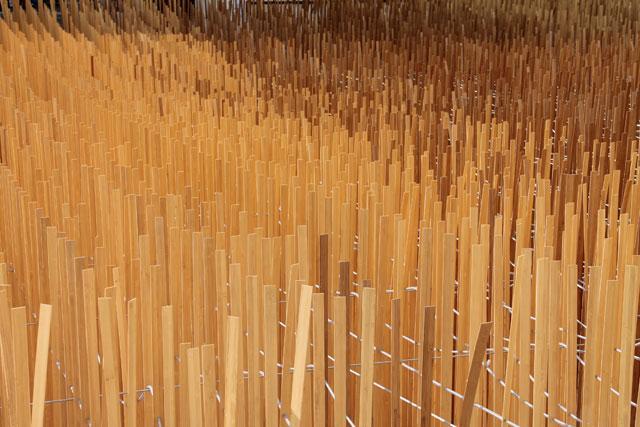AMMAN — Upon entering Amman Design Week’s (ADW) Zain cultural space at Al Hussein Cultural Centre, the visitor is struck by a free flowing installation of 10,300 pieces of bamboo strips stretching over nearly 300sq.m.
This is “Dalieh”, an installation designed and built by Arini, a non-profit private study and research institution that curates and promotes studies in the fields of design, architecture and urbanism.
Along with his sister Liyan Jabi and Heba Najada, Mohammad Aljabi founded Arini in 2012 to “expand the creative realm and advance the practice of architecture and urbanism beyond its traditional definition”, according to Arini’s website.
“We wanted to bridge the gap between the huge supply of Jordanian designers coming out of universities and the lack of opportunities in the Kingdom,” Aljabi told The Jordan Times on the ADW premises in Ras Al Ain.
The trio was commissioned by ADW to create a roof-like installation providing a cover for the cultural space, to protect it from the heat in an innovative way.
Dalieh — which means grapevine in Arabic — is a suspended installation that was inspired by Alejandro Aravena’s piece of scrap metal exhibited in the 2016 Venice Architecture Biennale, but with a much lighter twist, Aljabi explained.
“We used the theme of this year ‘Design Moves Life Moves Design’ to create a constantly moving installation. Each strip flows with the wind and the shadows they create are always changing,” he continued.
The creation, which provides a completely different picture depending on the viewer’s perspective, aims to question the “sense of spatial ambiguity” from various angles.
“If you sit under it, it will be very clear, you will be able to see the sky and the stars at night. However, if you stand on the side, you will see a kind of concrete wall of bamboo strips,” the designer noted.
Dalieh was created in collaboration with Zawayed, a community organisation working with Palestinian refugees living in Jabal Al Natheaf in eastern Amman.
“We believe that design is not only meant to be pretty; it can also unlock a lot of potential to generate income,” Aljabi stated, adding that Arini works with the residents of the camp to enhance their socio-economic conditions and improve the built environment they live in.
“When working with the local community who for somehave been here since the 1950s, we enter a learning experience for all of us,” he stated, noting that Arini’s projects draw on the varied backgrounds of its three founders.
“My sister Liyan works mostly with Zawayed to trigger social change in marginalised groups while Heba, who is currently pursuing her PhD in the US, focuses on the issues of transnational relations and flows of refugees, dispossession and diaspora,” Aljabi explained.
“Design should not limited to superficial beauty; it also involves the ethics and politics of humanitarianism, and can be used to tackle the environmental, cultural, socio-economic challenges,” he stressed.
“We chose to work with the people from Jabal Al Natheaf because this is an area that was overly understudied. The practice of design and architecture in the Arab world is still lagging behind while it could really make a change in people’s lives,” Aljabi who is also one of the founder of herskhazeen.com, an online magazine for architecture and design in the Arab world, concluded.
Source: http://bit.ly/2i02u4l











